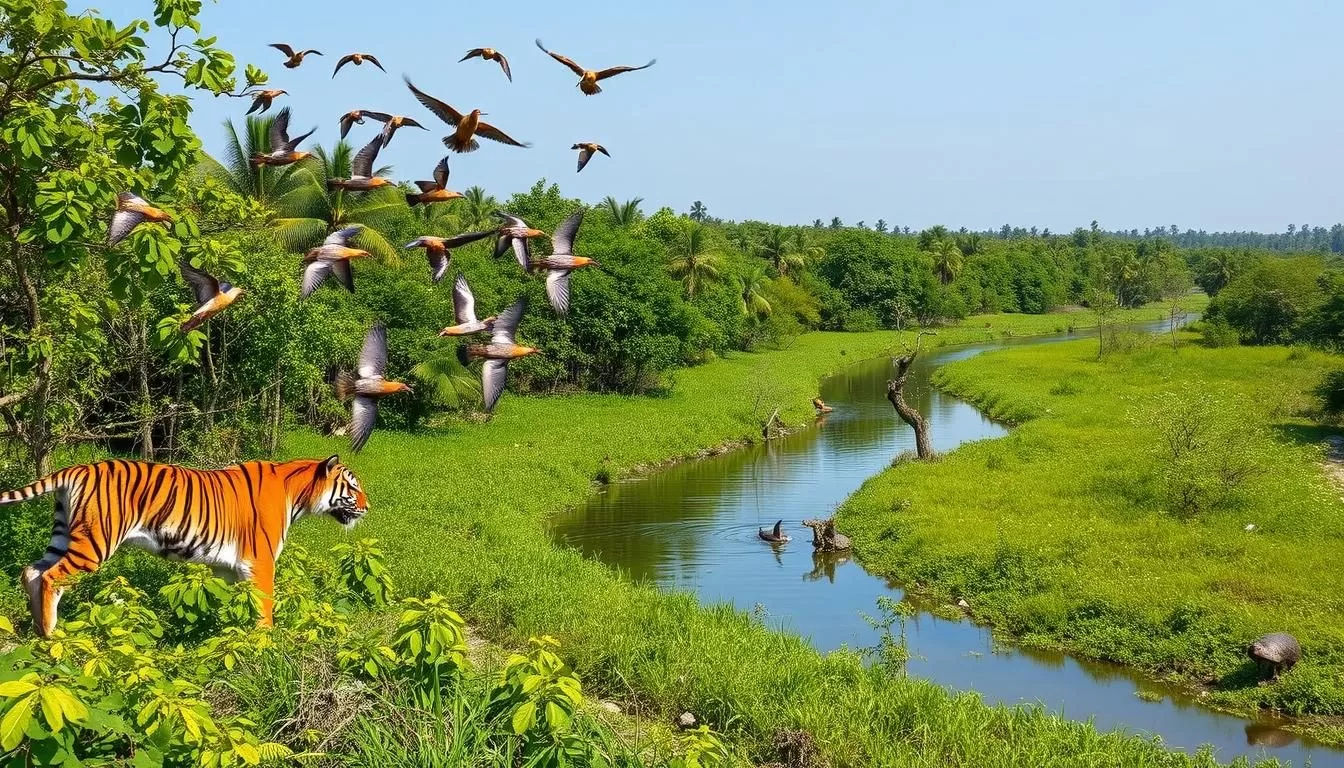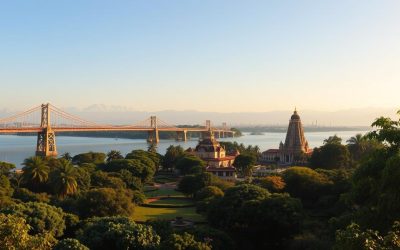Imagine exploring the world’s largest mangrove forest, home to an incredible array of wildlife, including the majestic Royal Bengal Tigers. Located in West Bengal, Sundarbans National Park is a UNESCO World Heritage site that offers an unparalleled adventure for nature enthusiasts and wildlife lovers.
You’ll have the opportunity to witness a diverse range of species in their natural habitat, from tigers and rhinos to leopards and numerous bird species. The unique ecosystem where land meets water creates a biodiversity hotspot that’s a treat to explore.
As you venture into this extraordinary national park, you’ll discover thrilling experiences such as boat safaris through winding waterways and wildlife spotting from strategic watchtowers. Whether you’re a nature photographer, birdwatcher, or simply seeking a unique travel experience, Sundarbans has something special for every type of visitor.
Discovering the Unique Ecosystem of Sundarbans National Park
Sundarbans National Park is a treasure trove of biodiversity, boasting an intricate ecosystem that is as fascinating as it is fragile. As you explore this natural wonder, you’ll uncover the complex interactions between the park’s diverse wildlife and its environment.
The World’s Largest Mangrove Forest
The Sundarbans is renowned for being the world’s largest mangrove forest, a distinction that underscores its ecological significance. This vast network of mangrove forests is not just a haven for wildlife; it’s also a critical component of the global ecosystem, supporting a wide range of species that depend on this unique environment for survival.
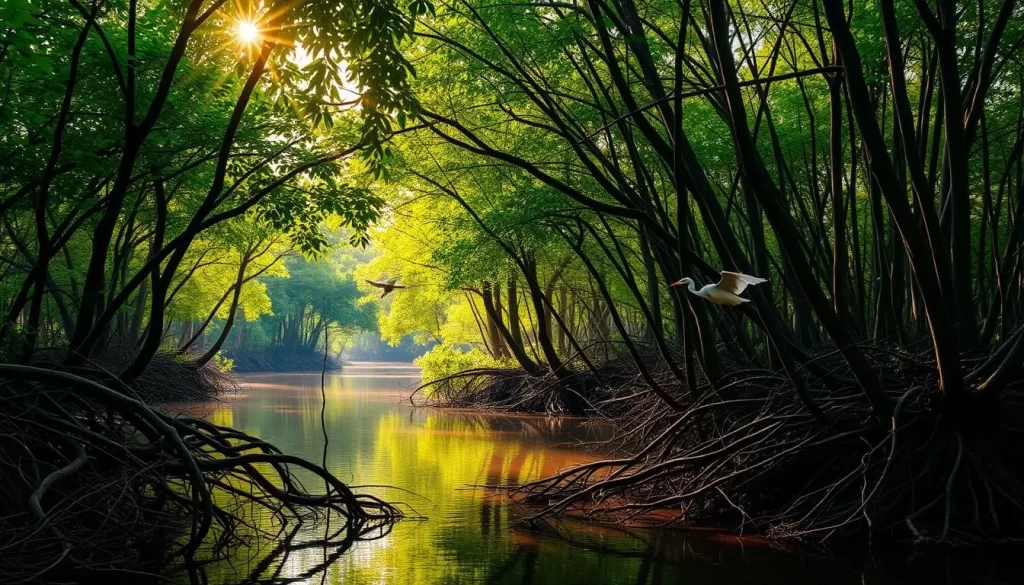
UNESCO World Heritage Site Status
In 1987, Sundarbans National Park was awarded UNESCO World Heritage Site status, recognizing its outstanding universal value as a unique ecological treasure. This designation has played a crucial role in protecting the park’s remarkable biodiversity, including rare and endangered species. Some key aspects of this designation include:
- Recognition of its exceptional natural beauty and importance as a living laboratory for studying ecological processes.
- Acknowledgment of its role as a critical carbon sink, helping mitigate climate change.
- Support for conservation efforts that preserve this fragile ecosystem for future generations.
Boat Safaris Through the Mangrove Forests
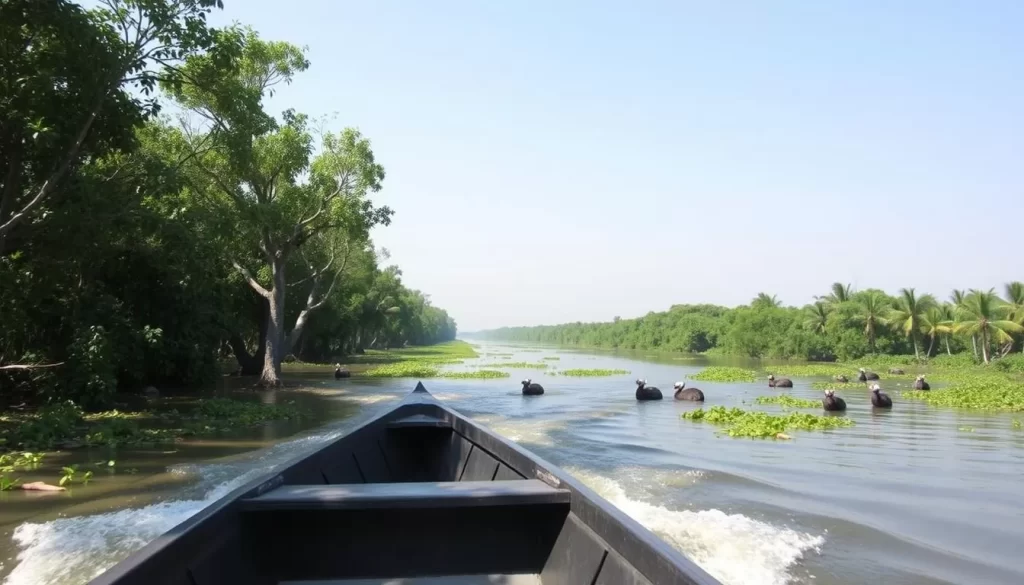
Embark on an unforgettable journey through the Sundarbans National Park with a boat safari that promises breathtaking views and thrilling wildlife encounters. The boats are explicitly made with the finest quality wood and other materials to view the forest’s flora and fauna.
Types of Boat Safaris Available
Sundarbans National Park offers various types of boat safaris catering to different preferences and interests. You’ll travel in vessels specially designed for wildlife viewing, with comfortable seating on the deck that provides excellent vantage points for spotting animals.
The tour operators provide different packages, including day tours and overnight cruises, ensuring that you have a memorable experience.
What to Expect During Your Boat Journey
During your boat journey through Sundarbans, you can look forward to delicious meals and snacks prepared and served onboard by dedicated culinary staff. The highlight of your boat safari will likely be spotting crocodiles basking on mudbanks or swimming stealthily through the water.
- Keep your camera ready at all times, as you might be lucky enough to glimpse the elusive Royal Bengal tigers coming to the water’s edge, especially during the early morning or late afternoon hours.
- Your experienced guide will help you identify various mangrove species and explain their ecological importance while pointing out smaller creatures like water monitors, fishing cats, and the diverse bird life that makes the forests their home.
Wildlife Spotting: The Royal Bengal Tigers and Beyond
With its unique mangrove ecosystem, Sundarbans National Park is home to a wide variety of wildlife, from majestic tigers to playful monkeys. The park’s diverse habitat supports a rich array of species, making it a paradise for nature lovers and wildlife enthusiasts.
Tracking the Elusive Royal Bengal Tigers
The Sundarbans is renowned for its population of Royal Bengal tigers. Tracking these elusive creatures in their natural habitat is a thrilling experience. Although spotting them can be challenging due to their elusive nature, the dense mangrove forests and waterways of Sundarbans provide a unique opportunity to catch a glimpse of these majestic animals in their element.
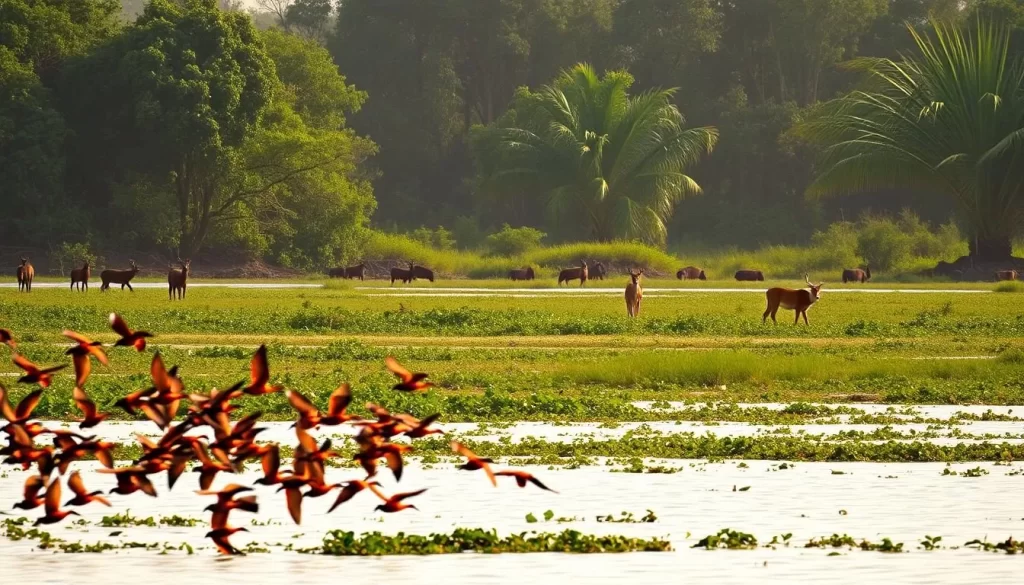
Other Wildlife Species to Look For
Beyond the famous Royal Bengal tigers, Sundarbans National Park is home to an impressive diversity of other species. You can spot spotted deer, wild boars, and rhesus macaques near the water’s edge. The waters and mudbanks are inhabited by impressive reptiles, including massive crocodiles and water monitor lizards. The park is also a haven for birds, with various species calling it home. During certain seasons, you might even spot Olive Ridley turtles nesting on the sandy beaches, adding to the park’s rich biodiversity.
Exploring the Sundarbans National Park Watchtowers
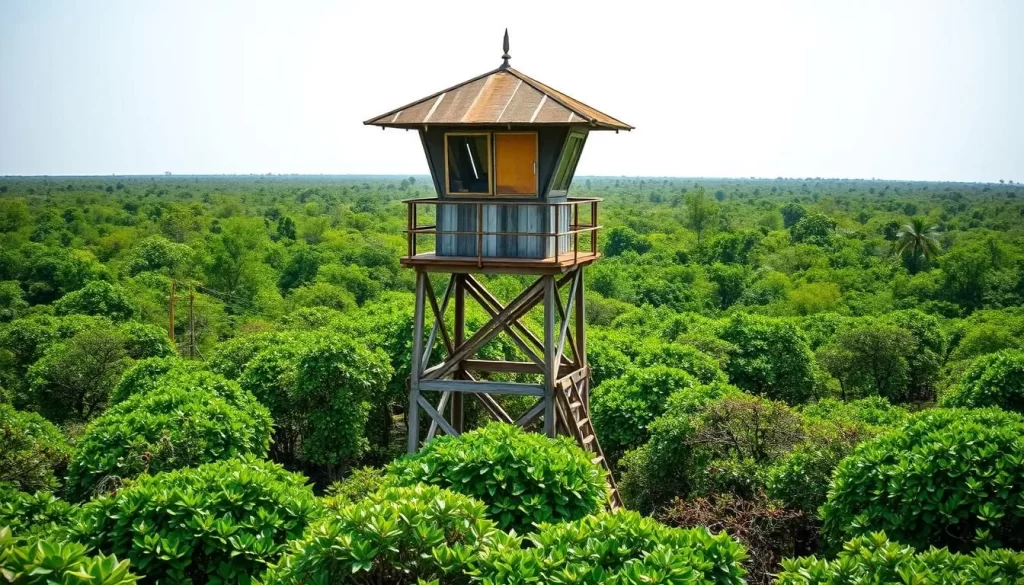
As you venture into Sundarbans National Park, the watchtowers stand as sentinels, offering a glimpse into the rich biodiversity of the region. These structures are crucial for both conservation efforts and enhancing the visitor experience.
Sajnekhali Watch Tower: The Main Observation Point
Sajnekhali Watch Tower is a primary observation point within the park, known for its strategic location that offers insights into the Sundarbans’ ecosystem. It’s an ideal spot for observing wildlife, including various bird species.
Sudhanyakhali Watch Tower: Prime Tiger Spotting
Sudhanyakhali Watch Tower is renowned for prime tiger spotting opportunities. Visitors can enjoy panoramic views of the surrounding forest while keeping an eye out for the elusive Royal Bengal tiger.
Dobanki Watch Tower and Canopy Walk
Dobanki Watch Tower offers a unique experience with its canopy walk, allowing visitors to immerse themselves in the Sundarbans National Park ecosystem. The elevated walkway provides a thrilling way to observe birds and other wildlife from a new perspective.
The Dobanki Watch Tower experience includes:
- A canopy walkway that offers a bird’s-eye view of the mangrove forest.
- Opportunities to spot various bird species at eye level.
- Panoramic views of the surrounding landscape from the tower.
Visiting these watchtowers is a must for anyone exploring the national park, providing an enriching experience amidst nature.
Birdwatching Paradise: Avian Species of Sundarbans
With its diverse ecosystem, Sundarbans National Park provides a perfect setting for spotting numerous bird species, from the majestic white-bellied sea eagle to the elusive masked finfoot. The park’s unique environment, characterized by lush mangrove forests and tidal creeks, attracts a wide range of wildlife, including a rich variety of birds.
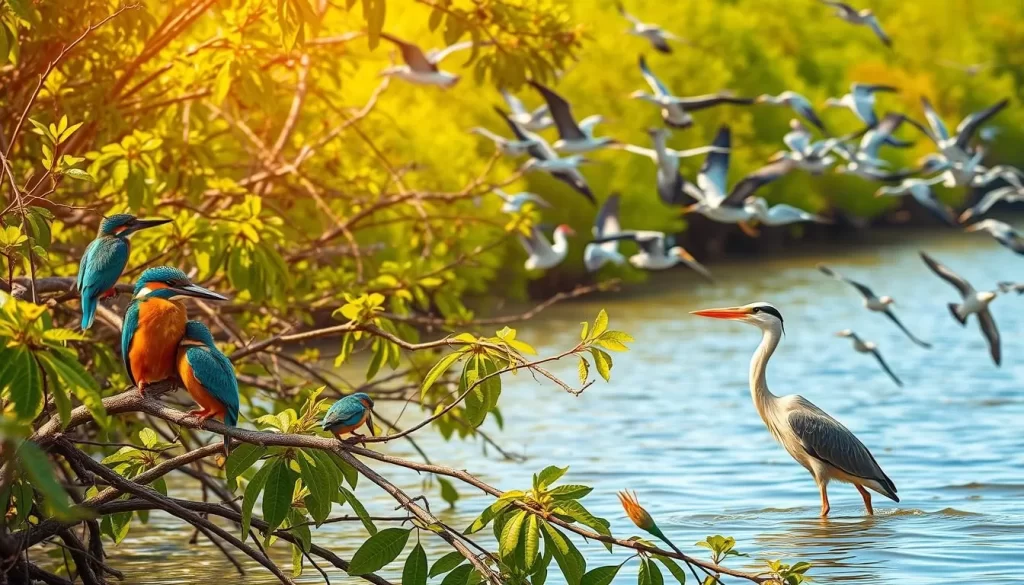
Resident Bird Species to Spot
The Sundarbans is home to a variety of resident birds, including kingfishers, herons, and egrets. These species can be spotted throughout the year, adding to the park’s vibrant avifauna. The dense mangrove forests provide a perfect habitat for these birds, with plenty of opportunities for nesting and foraging.
Migratory Birds and Best Seasons for Birdwatching
The best time to visit Sundarbans for birdwatching is between November and February, when numerous migratory species arrive from as far as Siberia and Europe. During this period, you can spot winter visitors like the common sandpiper and black-tailed godwit, among others. To make the most of your birdwatching experience, it’s recommended to visit during the early morning and late afternoon when birds are most active.
One-Night and Two-Night Cruises in Sundarbans

Experience the magic of Sundarbans with overnight cruises that offer a unique blend of adventure and relaxation. The West Bengal government operates two main cruise boats, Chitralekha and Sarbajaya, offering various accommodation options to suit your preferences and budget.
Cruise Routes and Experiences
The cruise journey takes you deep into the Sundarbans, offering a chance to witness the rich wildlife and diverse flora. You’ll sail through the waterways, getting up close to the mangrove forests and spotting local fauna. The tour is designed to make the most of your day and time in Sundarbans, balancing exploration with relaxation.
Accommodation and Amenities on Board
The boats are thoughtfully designed, featuring comfortable seating on deck and large windows in the cabins. You’ll enjoy food prepared by skilled onboard chefs, with meals featuring local specialties, including fresh seafood. The food is a highlight of your trip. The sleeping quarters are clean and comfortable, providing a welcome respite after a day of exploration.
Experiencing Local Culture and Cuisine
The Sundarbans experience is incomplete without immersing yourself in the local culture and savoring the unique flavors of the region. As you explore this unique ecosystem, you’ll have the opportunity to engage with the local communities and understand their way of life.
Cultural Heritage of Sundarbans
The indigenous cultural heritage of Sundarbans is rich and diverse, shaped by the region’s history and its interaction with nature. The local people have developed a distinct culture that is adapted to the challenging environment of the mangrove forests. You can experience this vibrant culture by visiting local villages and interacting with the people.
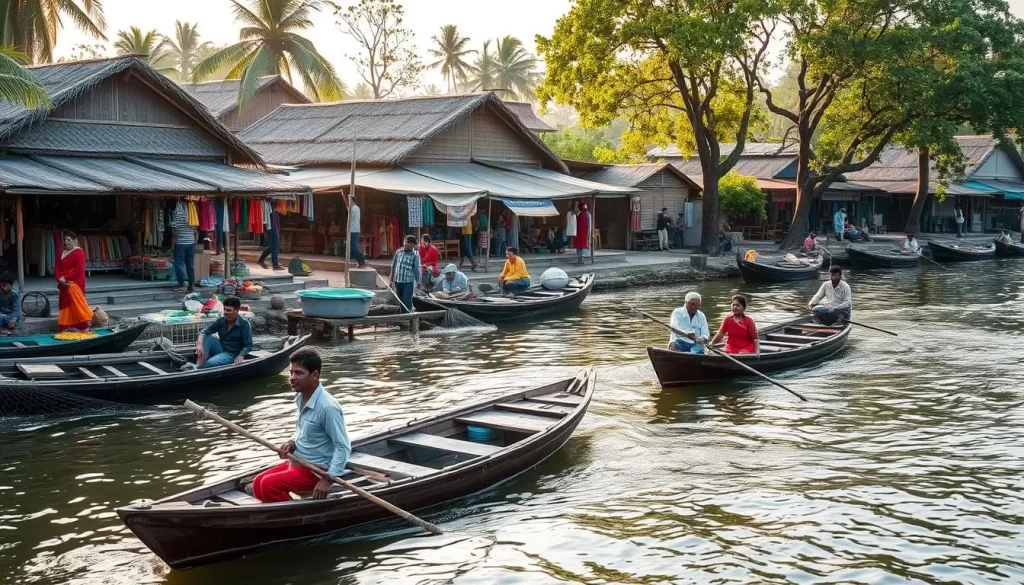
Local Cuisine and Traditional Dishes
The cuisine of Sundarbans is characterized by its abundant use of fresh seafood, with popular dishes featuring fish, crabs, and prawns. Some of the local favorites include “Bhapa Ilish” (steamed hilsa fish) and “Chingri Malai Curry” (prawns in coconut gravy). These dishes are prepared using traditional recipes and simple, rustic methods that highlight the natural flavors of the ingredients. By trying these local specialties, you’ll not only enjoy a culinary adventure but also gain insights into the daily life and food culture of the people in this region.
Burir Dabri Cage Trail and Mud Walk Adventures

Discover the hidden treasures of Sundarbans on the Burir Dabri Cage Trail and Mud Walk Adventures. The Sundarbans National Park offers a unique blend of adventure and wildlife exploration.
What to Expect on the Mud Walk
During the mud walk, you can expect to traverse through the mangrove forests and mudflats, getting up close with the natural habitat of various species, including Monitor Lizards and saltwater crocodiles. The experience is both exhilarating and educational.
Safety Tips and Best Time for Mud Walks
The best time for mud walks is during the dry season, from November to February. Always participate with authorized guides and wear appropriate footwear to ensure a safe and enjoyable experience. Be vigilant, as the ecosystem is home to dangerous animals like crocodiles.
Visiting Kanak Sanctuary and Other Nearby Attractions

For a comprehensive wildlife experience in Sundarbans, visiting the Kanak Sanctuary is essential. The sanctuary is known for its conservation efforts, particularly for the Olive Ridley Turtles.
Olive Ridley Turtles at Kanak Sanctuary
The Kanak Sanctuary is a nesting ground for Olive Ridley Turtles, an endangered species. Conservation programs here work tirelessly to protect these turtles and their habitats, offering a unique opportunity for visitors to witness these efforts firsthand.
Other Notable Sanctuaries in the Region
Beyond Kanak Sanctuary, the Sundarbans region is home to several other notable wildlife sanctuaries. Halliday Island Wildlife Sanctuary is renowned for its birdwatching opportunities, with diverse habitats supporting numerous resident and migratory bird species. Lothian Island Wildlife Sanctuary boasts pristine beaches and mangrove forests harboring a variety of wildlife, including spotted deer and rhesus macaques. The Bhagabatpur Crocodile Project offers insights into conservation efforts for the saltwater crocodile, allowing visitors to observe these reptiles at various life stages.
Many tour operators offer customized packages that include visits to multiple sanctuaries, enabling you to experience the full spectrum of biodiversity in the Sundarbans region. By incorporating these sanctuaries into your tour, you can enjoy a more comprehensive and memorable wildlife experience in Sundarbans National Park.
Conclusion: Planning Your Perfect Sundarbans National Park Adventure
To make the most of yourSundarbans National Parkadventure, it’s essential to plan carefully, considering factors like the season and your interests.
When planning your trip, consider visiting between November and February for the best experience. This period offers pleasant weather and increased wildlife visibility, making it ideal for spotting tigers and other fauna.
You should also consider booking a comprehensive package that includes boat safaris, watchtower visits, and cultural experiences to ensure a diverse and enriching experience. Pack essentials like binoculars, a good camera, and neutral-colored clothing to enhance your wildlife viewing experience and enjoy the bird species and flora of the park.
The above is subject to change.
Check back often to TRAVEL.COM for the latest travel tips and deals.
